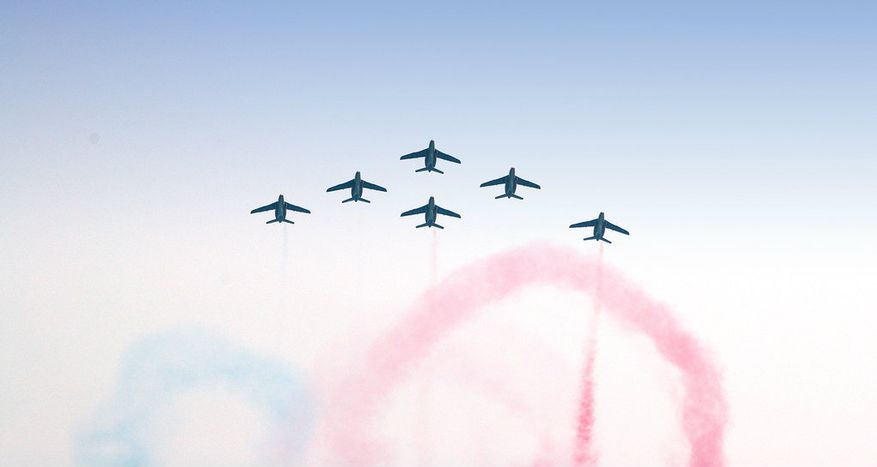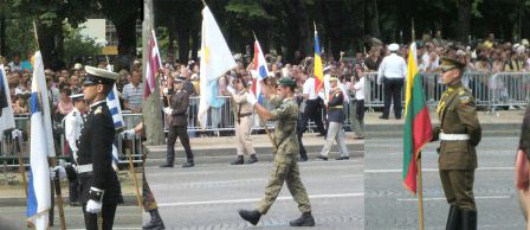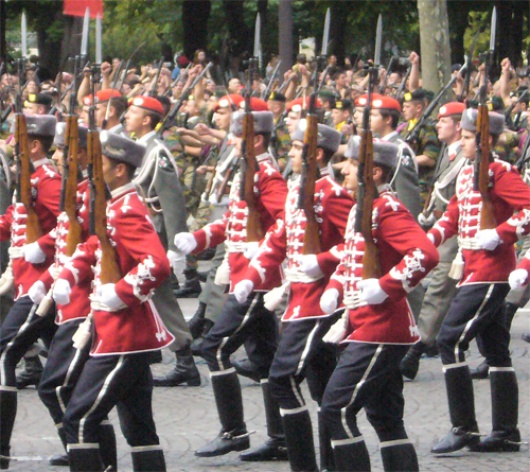
On July 14th, Europe was in Paris
Published on
So as to stress “France’s way back in Europe” and “Europe’s way back in France”, the new French President, Nicolas Sarkozy, had decided, one day after his election, that July 14th demonstrations would be the opportunity to have all the European countries parading together. He kept his promise and La Parisienne, was present to bring you back pictures.
 Reaching the Champs Elysées on July 14th is not that easy, especially if you don’t get a “VIP” invitation or a press card. There is no other solution that following the strollers along the path delineated by the police. Even if you come two hours earlier, the crowd is already formed. The safety gates’ area is already crammed full. In clear, you’d better be tall and find the best place remaining. But first of all: you shouldn’t forget to be body-searched.
Reaching the Champs Elysées on July 14th is not that easy, especially if you don’t get a “VIP” invitation or a press card. There is no other solution that following the strollers along the path delineated by the police. Even if you come two hours earlier, the crowd is already formed. The safety gates’ area is already crammed full. In clear, you’d better be tall and find the best place remaining. But first of all: you shouldn’t forget to be body-searched.
All around, you can hear speaking French but many other languages too: English, German, Polish, Japanese, and many more. Tourists are also part of it. What is this year’s Special ? Answer : Some of these tourists will see their own army parade...
 For the first time in history, the President of the French republic has invited all the European countries to march-past on the Champs Elysées to celebrate the French National day. All the 26 accepted. The total participants reached not less than 800 people, all dressed up in different uniforms but still parading under the same flag: the European Union’s. It was hold by Lieutenant Edouardo Gomes from the lancers’ ragiment based in Lisbon. The day preceding D Day, he declared during the training session: “I realize all the faith that my superiors have put in me. It is a great honour for me and I can’t deny that my concentration will be at its utmost on Sunday morning, and during all our marching down the most beautiful avenue of the world.”. Generally, the armies were composed of thirty soldiers. For some countries, the numbers were smaller : eight for Denmark, four for Malta.
For the first time in history, the President of the French republic has invited all the European countries to march-past on the Champs Elysées to celebrate the French National day. All the 26 accepted. The total participants reached not less than 800 people, all dressed up in different uniforms but still parading under the same flag: the European Union’s. It was hold by Lieutenant Edouardo Gomes from the lancers’ ragiment based in Lisbon. The day preceding D Day, he declared during the training session: “I realize all the faith that my superiors have put in me. It is a great honour for me and I can’t deny that my concentration will be at its utmost on Sunday morning, and during all our marching down the most beautiful avenue of the world.”. Generally, the armies were composed of thirty soldiers. For some countries, the numbers were smaller : eight for Denmark, four for Malta.
The French Defence minister, Hervé Morin, expressed himself about the event: “ It is a great pleasure, a great pride too, to welcome a delegation of our 26 partners of the European Union for our National day and the maarching of our forces. France wanted to organize this gathering under this Portuguese presidency to illustrate our member States’ willingness to write a new page of our common history.”
A few minutes before the H hour, the European troops made a perfect line. The 28 flag holders, who were preceding the detachment, drew a V. In the forefront: Portugal, who leads the ongoing EU presidency, was siding Germany which had just passed its mandate, and Slovenia who will take the next January presidency.
When they were told to, soldiers started walking. The pattern was the same for all : 115 steps per minute. Everybody had to follow the French rhythm to keep a good balance. But specificities still remained: some raised their arm; others raised their foot or beat the floor more strongly, keeping a high chin. A feeling of diversity floated, but unity was still there.
 The V kept straight, progressing towards the grandstand where all the highest officials of the European Union were sat: José Manuel Barroso, President of the European Commission, Hans-Gert Pöttering, President of the European Parliament and Javier Solana, High representant of the EU diplomacy. When the parade’s finished, the French President and themselves bow to the European flag holders.
The V kept straight, progressing towards the grandstand where all the highest officials of the European Union were sat: José Manuel Barroso, President of the European Commission, Hans-Gert Pöttering, President of the European Parliament and Javier Solana, High representant of the EU diplomacy. When the parade’s finished, the French President and themselves bow to the European flag holders.
José Manuel Barroso positively welcomed the initiative and declared that it was not a symbolic gesture but a strong message for France and for all Europe. “ In a world of globalization”, he said, “it is necessary to defend our own interest and values together, as Europeans”. Eventually, he underlined that there was no contradiction between patriotism and European spirit.
 Among the crowd (120.000 people according to the police), some uniforms or flags puzzle many watchers, and some amazing remarks could be heard: “what is it this red and green flag ?” or “oh, really, those are in Europe too now ?” These few geography deficiencies did not prevent Parisian people from applauding with dew consideration their European neighbours, just like they did for the French troops.
Among the crowd (120.000 people according to the police), some uniforms or flags puzzle many watchers, and some amazing remarks could be heard: “what is it this red and green flag ?” or “oh, really, those are in Europe too now ?” These few geography deficiencies did not prevent Parisian people from applauding with dew consideration their European neighbours, just like they did for the French troops.
 Once the march-past finished, some of the European soldiers attended the Elysée’s Garden Party. But they could also be seen in the Parisian streets, lingering and discovering the French capital which had become, for one day, a symbolic European capital.
Once the march-past finished, some of the European soldiers attended the Elysée’s Garden Party. But they could also be seen in the Parisian streets, lingering and discovering the French capital which had become, for one day, a symbolic European capital.



